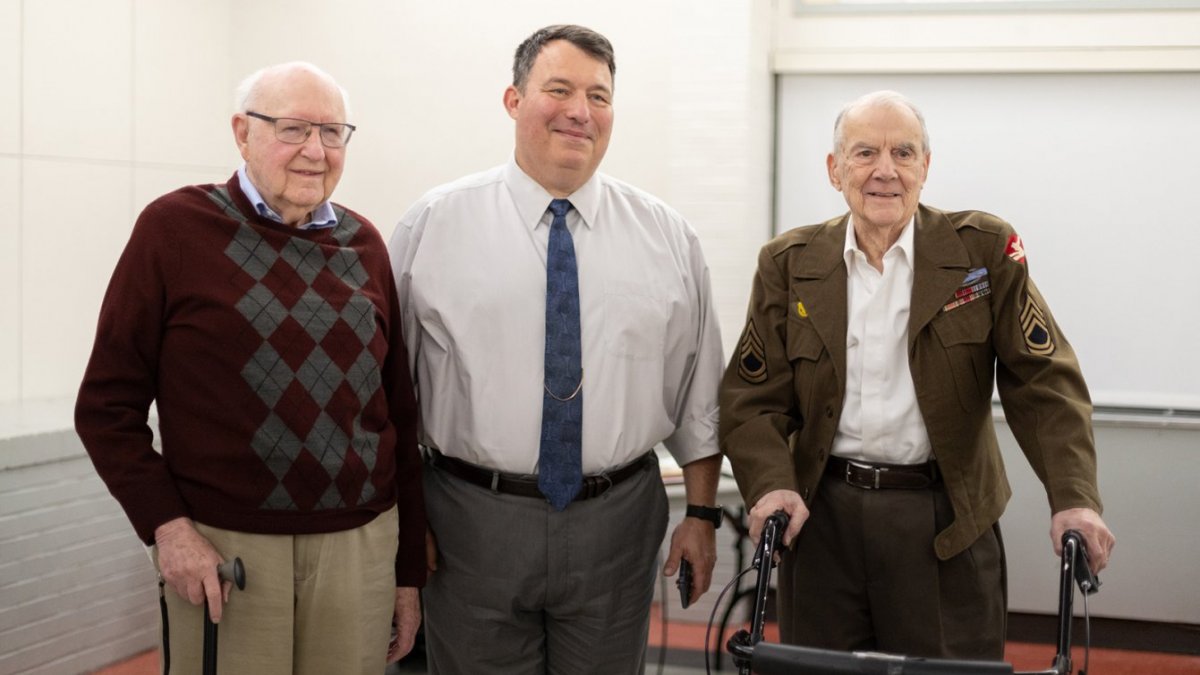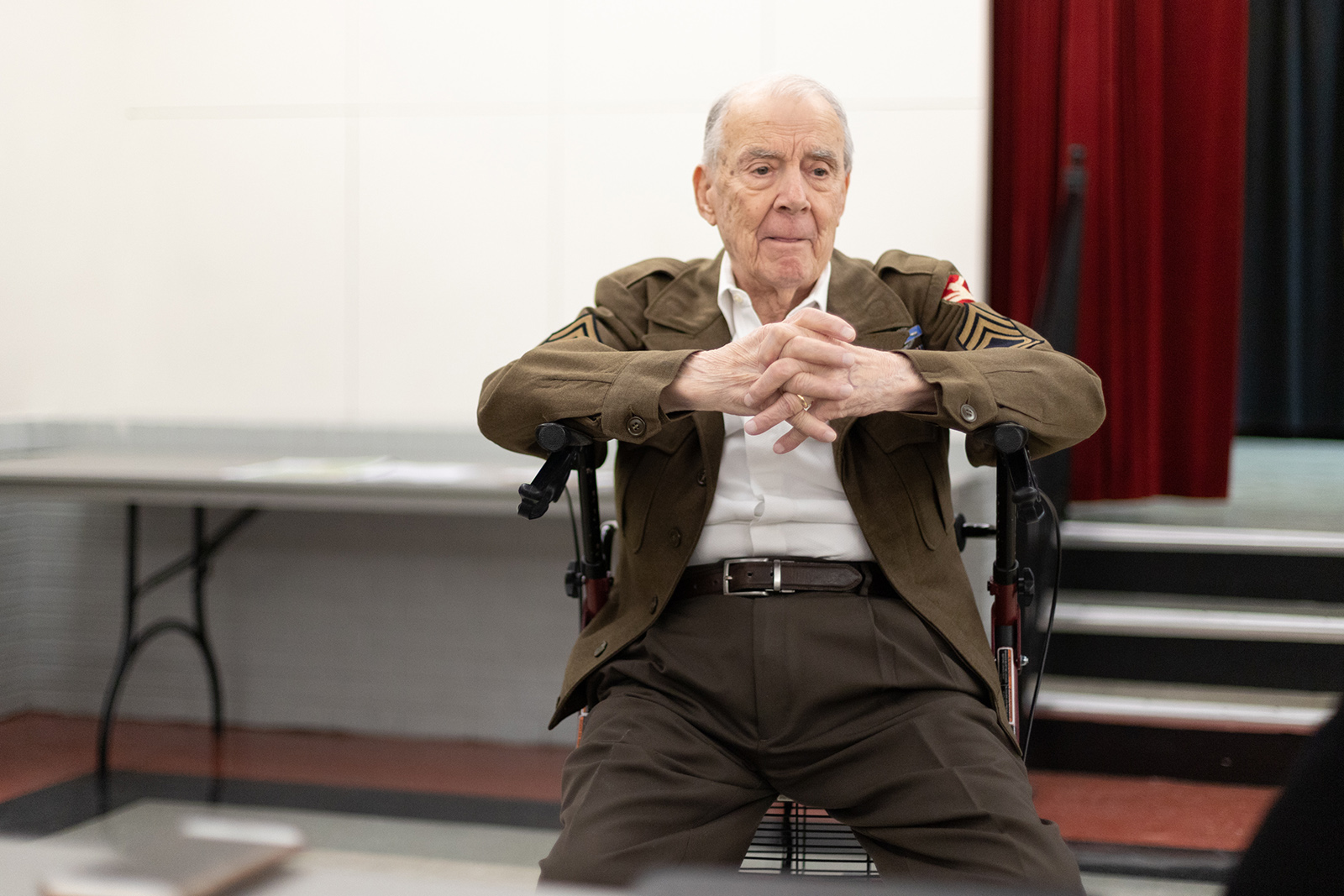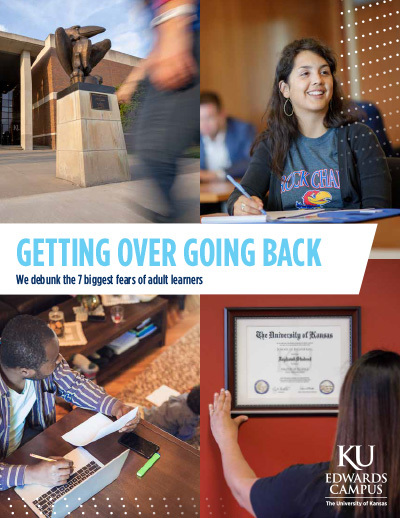Local Battle of the Bulge veterans share firsthand experience of the battle won 75 years ago

U.S. Army veterans Kenneth Tebow and John Martin brought history to life in Mark Gerges’ KU Osher Lifelong Learning Institute course, “The Battle of the Bulge: Germany’s Last Blitzkrieg, December 1944.” At 99 and 96 years old, respectively, they live to tell the human experience behind one of the most poignant battles of the Second World War.
Part of KU Professional & Continuing Education, KU’s Osher Lifelong Learning Institute offers short-term enrichment courses specifically developed for those aged 50 and older. Gerges – an Army veteran himself, having served 20 years as an armor officer, and associate professor of history with the U.S. Army Command and General Staff College – has been teaching for the Osher Institute for nine years. Never before has he had a class participant with first-hand experience in his subject matter.
“It’s been wonderful,” Gerges said. “It’s such an honor to have these two actual veterans in the classroom. We also had people whose relatives were killed in the Battle of the Bulge. It’s amazing to see and hear from these pieces of tangible history.”
Pointing at his PowerPoint slide up on the screen before the last session on Nov. 4 at the Roeland Park Community Center, Gerges emphasizes the photo of soldiers in the snowy climate during the battle. “It’s incredible what they suffered and went through,” he said. “And the Battle of the Bulge is the U.S. Army’s single greatest victory, ever, and to have an infantryman [Martin] and a man from the 106th Infantry Division [Tebow] is incredible. They are humble about it, but they both played key roles in the Battle of the Bulge. I was amazed when I heard they were here in the room.”
The Battle of the Bulge refers to the month-long, surprise German counteroffensive in the Ardennes Forest from December 1944 to January 1945, just five months before WWII’s end in Europe. The Germans broke through an exhausted American front, creating a protrusion, giving the battle its famous name. American troops were able to eventually push back “the bulge,” but not without significant losses, with 75,000 American casualties and 80,000-100,000 for the Germans.
With the plethora of historical renditions, documentaries and written works about this significant battle, certain details Tebow and Martin said remain to be overshadowed.
“I like to think if it wasn’t for our division, the Germans might have gotten much more advanced,” Martin said. “I was in the 84th Division in the Ninth Army, and we stopped them at the point of the bulge in the town of Marche [Belgium]. […] It was six to eight miles from the Meuse River. If they could have crossed that river, they could have had a good run at Antwerp Seaport where all our supplies were coming in, or they could have made it to Paris, which would have been a monstrous morale builder for the Germans.”

Martin said the 84th Infantry Division was ordered down to Marche on Dec. 19, three days after the German counteroffensive began. “We had no idea what we were headed toward,” he said. “We got there by the morning of the 21st and defended the town from that point on. If the Germans would have gone in the night of the 20th, they could have just walked in. It was all a matter of timing.”
Martin was an infantryman in 3rd platoon, A company, 1st Battalion, 335th Infantry Regiment 84th Infantry Division. As a young man in Chicago, he originally tried to join the Navy in 1942. When it turned out he was red-green color blind, he was told to go home and wait for the draft. Martin was drafted into the U.S. Army in March 1943.
Part of the Army Specialized Training Program, which was designed to give soldiers technical skills, Martin was sent to Virginia Tech in what was supposed to be a two year program, but the Army decided to shut down the program in February 1944. He then became an infantry private in Louisiana where he joined the 84th Infantry Division. The unit headed to England before being shipped to France in early November 1944.
Tebow also headed overseas in fall 1944 as part of the storied 106th Infantry Division. Tebow was a technical sergeant, top noncommissioned officer in a band. He also served as assistant director and drum major, playing trumpet and the French horn. His road to the Battle of the Bulge began when he went into the Missouri National Guard around 1938. The U.S. federalized the National Guard shortly after and sent them to South Carolina for some time. “I remember being on my bed listening to the radio on a Sunday afternoon,” he said. “They said, ‘We have a bulletin. The Japanese have bombed Pearl Harbor.’ I knew then that it was going to be a long-term situation.”
After a stint in the Air Force, Tebow was sent back to ground forces because of Air Force officer oversupply and was assigned to the 106th Infantry Division, which was headed to the Vielsalm, Belgium, area.
“We were new on the line, and we were ‘green,’ having never been in combat before,” Tebow said. “They [commanders] said not to worry; it’s going to be quiet, and we could build a fire in our fox holes. Then the onslaught came, and we were in the very center of it. They had moved two other divisions out and spread us on a 30-mile front. Our division lost over half its men, which was around 7,000-7,500. I happened to be in the rear echelon headquarters, where I was in charge of the guard. It was quite a trying experience. One of the things I don’t think people ever understood is what it’s like when you’re in that situation and you’ve got bullets flying, cold snow, and all of the things that go with combat. When people look at the pictures [from the Battle of the Bulge], they think, ‘Wow, it was cold.’ There’s just a lot more to it than that.”
The strikingly cold conditions, overwhelming losses and the sense of bewilderment and exhaustion still stick with the two men today, remembering these encompassing feelings vividly.
“I was in a rifle platoon,” Martin said. “We could only see what was 100 yards in front of us. You never know what’s going on, and the weather wasn’t particularly in our favor either. It was all defense until the third of January when we started pushing them back. But on that same day, started a real snow storm. It was always below freezing. For a rifleman, that was not fun. I wore two pairs of socks, two long johns, pants, shirt, jacket, army coat and even a raincoat to keep the wind off. The snow got to be ankle deep then knee deep. We couldn’t really sleep, and you wouldn’t really want to. If you fall asleep in the teens, you probably would never wake up. You would just doze a bit. It was tough, but, we survived. How we survived? To this day, I don’t know.”
Tebow remembers a happier moment in a small town church, where he and his comrades were invited to come in and rest. The main floor of the church was used as a station for German horses that were drawing the cannons and other supplies.
“We decided to go to the basement and sleep. The odor wasn’t as strong as it was up in the church area,” he said. “I remember thinking as I lay there, ‘what about those guys who were crying when we left because they didn’t pass the physicals? Here we are in the middle of all this.’ But the morning came, and it was Dec. 25, Christmas. We walked out of the basement, the sky was clear, the sun was shining and it seemed like thousands of airplanes were going overhead. It was the first time they were able to get air cover in for the people.”
This moment of relief, however, was short-lived as the reality of war reared its head in the sky.
“Then you’d see a flying fortress and it gets hit by an aircraft,” Tebow said. “You’d see maybe three parachutes come out, and you knew maybe six others were killed. You kind of get used to this killing. I remember we were in Stavelot, in the city plaza … they had civilians stacked having been killed by the Germans. These memories keep coming.”
Seventy-five years later, the emotions are still just under the surface. Martin lost three company commanders during the six months he fought in World War II. He remembers all by name and with reverence. By the end of the war, Martin was a sergeant first class – which typically takes a soldier today 12-15 years to accomplish – a platoon sergeant, and then acting platoon leader when he was wounded.
“People have asked me over the years, ‘How did you manage to go ahead when you see all this death and destruction?’” Martin said. “I think about that a lot. If you’re an infantry rifleman, there’s nobody in front of you but the enemy. I remember sitting there back in those days, and I would look at the situation in my mind’s eye and say, ‘You know, I’m about 5,000 miles from Chicago, and I’m never going to get back.’ I thought the war would never end, and I was never going back. When you see comrades falling every day, every week, how do you manage that? You just figure, ‘I may as well make up my mind. I’m over here, the generals are telling me what to do and where to go. And, that’s it. If you start worrying about getting back home, you’d go nuts. I would just think ‘I’m probably going to get hit, I just hope it doesn’t hurt too much.’ You just get in the mindset you’re never going back. I know that sounds strange, but it really makes you feel better.”
Martin and Tebow did make it back and as years passed, they learned along with the rest of the world what was really happening during the now infamous Battle of the Bulge.
“I’ve read probably 12-15 books including from the Army’s history department, so now I have a pretty good idea of what took place,” Tebow said. "When you’re on the ground, you don’t really know what’s going on. Our generals didn’t know what was going on. Everything happened so fast.”
Not only were the ones on the ground fighting through confusion, friends and family in the states were often without accurate information.
“People back home didn’t have any more idea what was happening than we did,” Tebow said. “The radio announcer would update every Noon. My wife and family were listening, and he said the 106th Infantry Division was annihilated. It wasn’t until six weeks later they got word there was a remnant. I happened to be in that remnant.”

Tebow didn’t talk about the war until the 50th anniversary of the Battle of Bulge rolled around. At the nudge of family and friends, he then began to share about his experiences. When he and Martin discovered the Osher course covering this all too familiar battle 75 years later, they were ready to learn more.
“I thought Mark would want an eye witness to make sure what he said was true,” Martin joked. “He’s done a terrific job. He gives us the big picture. I know my situation. Mark’s explained a lot of the Bulge I didn’t know anything about.”
The battle isn’t the only anniversary on their minds. With a competitive spirit, both men announced before the last course on Nov. 4 they’re celebrating milestone wedding anniversaries. Tebow will soon celebrate 77 years with his wife, and Martin is celebrating 72.
Life after the war was rich for both men. Tebow and his wife had four children. He had a long teaching career that started at Northwest Missouri State, saw him earn his master’s at KU and led him to stay in Kansas from then on. He even taught band and orchestra classes in the very room where the Osher course was held.
Martin went on to have three children, earned his master’s in engineering from The Ohio State University and managed computer centers for Montgomery Ward for 30 years.
“The Battle of the Bulge: Germany’s Last Blitzkrieg, December 1944” course culminated on the heels of Veterans Day as Tebow and Martin reflect on military sentiment over time and their appreciation for “Thank you for your service” remarks on this day.
“I’ve noticed the reaction of people shift over time,” Tebow said. “After we came back, we had the Vietnam conflict, and people were against the military at that point, so the attitude of the American people was fluctuating. Now we’re kind of at a renaissance and everyone thinks this service thing is a pretty big deal.”
To these soldiers, to the fallen and to all who have served, thank you.
Top photo: Mark Gerges (center) – U.S. Army veteran, associate professor of history with the U.S. Army Command and General Staff College and instructor of the KU Osher Lifelong Learning Institute Course, “The Battle of the Bulge: Germany’s Last Blitzkrieg, December 1944” – stands with WWII and Battle of the Bulge veterans Kenneth Tebow (left) and John Martin (right) during the last session of his Osher course on Nov. 4 at the Roeland Park Community Center. Photo by Lindy Rhodes.
KU’s Osher Lifelong Learning Institute offers noncredit enrichment courses and events in accessible and innovative learning environments throughout northeastern Kansas and Greater Kansas City with a special focus for those 50 and “better," although learners of all ages and backgrounds are welcome. Sign up here to receive the catalog of upcoming classes!





